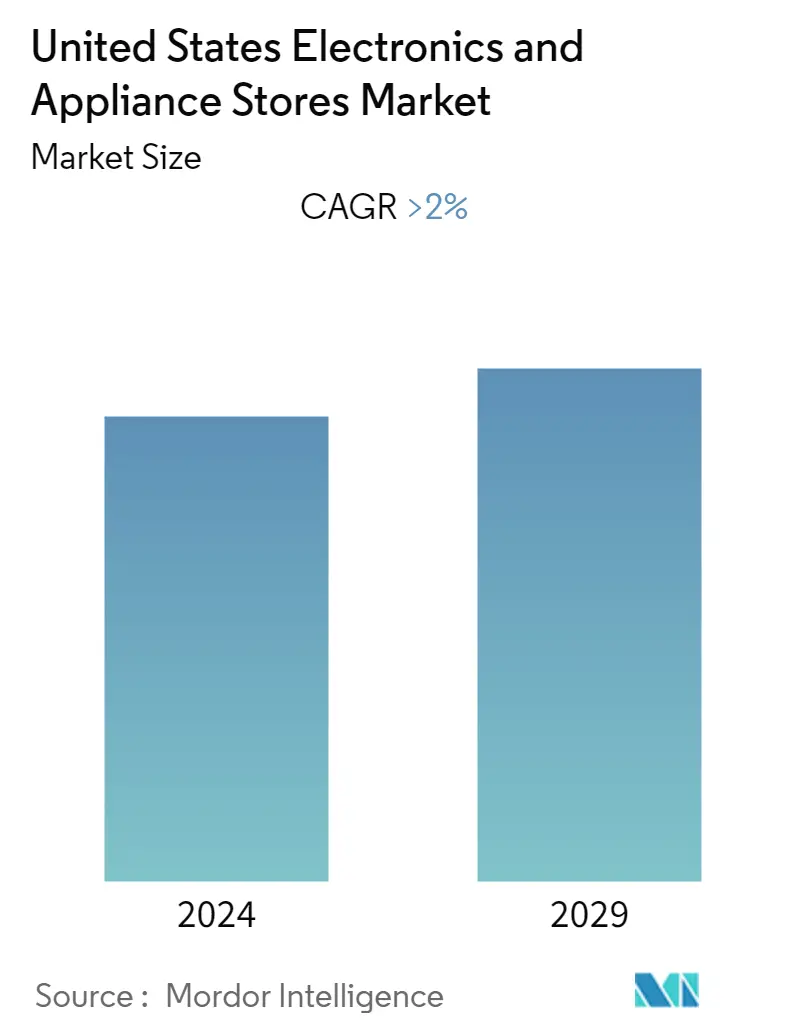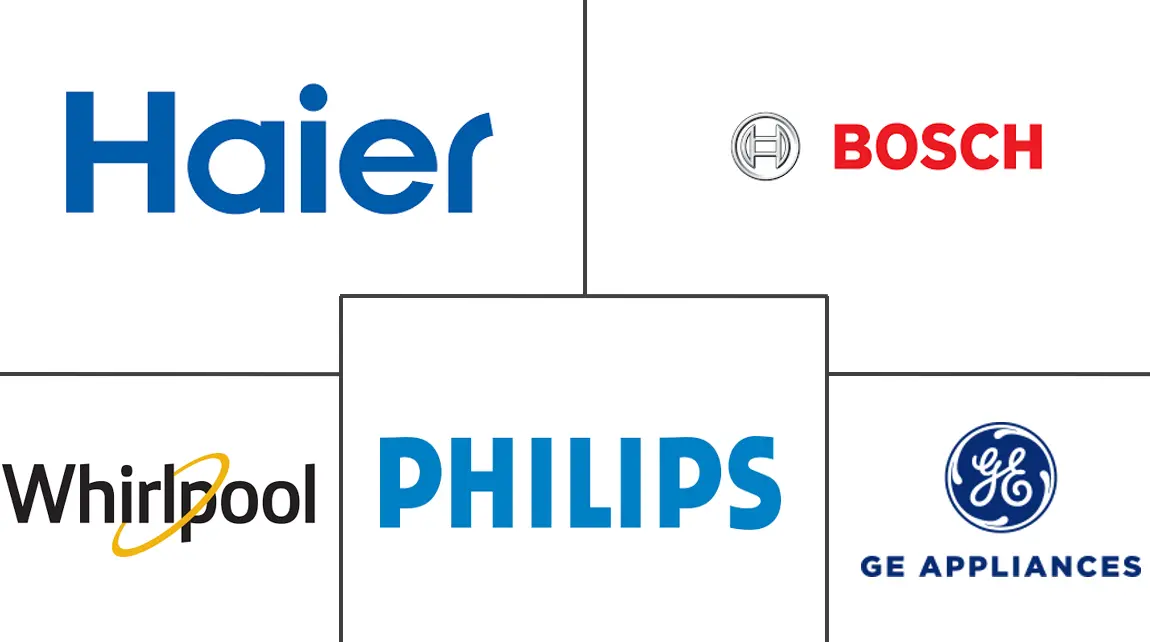Market Size of United States Electronics and Appliance Stores Industry

| Study Period | 2019 - 2029 |
| Base Year For Estimation | 2023 |
| Forecast Data Period | 2024 - 2029 |
| Historical Data Period | 2019 - 2022 |
| CAGR (2024 - 2029) | 2.00 % |
| Market Concentration | Medium |
Major Players
*Disclaimer: Major Players sorted in no particular order |
US Electronics & Appliance Stores Market Analysis
The United States Electronics and Appliance Stores Market is expected to register a CAGR of greater than 2% during the forecast period(2024-2029).
The electric appliance market over the period had focused on energy-efficient products and shifted towards sustainable and eco-friendly products. Enabling AI and IOT in electric appliances is revolutionizing the market with new features and controls.
With the advent of COVID-19, there arose a problem of supply chain disruptions in electrical appliances. As with the advent of COVID-19, consumers were spending more time at home, and a need arose for replacing or upgrading their appliances. Freezers and washing machines were among the appliances observing an increase in demand. With COVID-19, the frequency of use of electrical equipment observed a continuous increase; the use of washers and dryers was up by 25%, and the sanitizing cycle on washers was up by 85%. As a result, demand for equipment exceeds supply, causing delivery delays to customers.
As the economies are recovering and supply chains are recovering. Electric appliance stores are observing a steady state between the supply and demand of electric appliances. With the continuous recovery of sales in June 2021, monthly sales of electronics and appliance stores reached USD 8.49 billion, recovering from a decline of USD 3.52 billion in April 2020.
US Electronics & Appliance Stores Industry Segmentation
Stores that sell appliances and electronics to end consumers from fixed point-of-sale locations are known as electronics and appliance stores. The premises where electronics and appliance stores are normally run include space for floor displays and electricity to power product demonstrations.
The United States Electronics And Appliance Stores Market Is Segmented By Type (Hardware Suppliers, Security Stores, Consumer Electronics Stores), By Ownership (Retail Chain, Independent Retailer), And By Type Of Store (Exclusive Retailers/Showrooms, Inclusive Retailers/Dealer Stores, Online). The Report Offers Market Size And Forecasts For The United States Electronics And Appliance Stores Market In Volume (Number Of Stores) And Value (USD) For All The Above Segments.
| By Type | |
| Hardware Supplier | |
| Security Stores | |
| Consumer Electronic Store |
| By Ownership | |
| Retail Chain | |
| Independent Retailer |
| By Type of Store | |
| Exclusive Retailers/showroom | |
| Inclusive Retailers/Dealers Store | |
| Online |
United States Electronics and Appliance Stores Market Size Summary
The United States Electronics and Appliance Stores Market is poised for growth, driven by a focus on energy-efficient and sustainable products. The integration of AI and IoT technologies is transforming the market, introducing smart features and controls in appliances. The COVID-19 pandemic initially disrupted supply chains, leading to increased demand for appliances as consumers spent more time at home. This surge in demand resulted in delivery delays, but as supply chains recovered, the market began to stabilize. The recovery was marked by a resurgence in monthly sales, with a notable increase in the variety of products available to cater to diverse consumer needs and income levels. This variety has attracted more consumers to electronics and appliance stores, contributing to the market's recovery.
The market landscape is characterized by competition among key players such as Panasonic, GE Appliances, Aqua, Haier, Whirlpool, Bosch, Midea Group, Hitachi Limited, Candy, Philips, and Toshiba. These companies are expanding their distribution channels, including online platforms and specialty stores, to capture a larger share of consumer demand. Strategic partnerships and acquisitions, such as GE Appliances' collaboration with Google Cloud and Whirlpool's acquisition of InSinkErator, highlight the industry's focus on enhancing consumer experiences and expanding product offerings. The market's growth trajectory is supported by ongoing innovations and the increasing penetration of smart home devices, particularly those equipped with AI and IoT technologies.
United States Electronics and Appliance Stores Market Size - Table of Contents
-
1. MARKET DYNAMICS AND INSIGHTS
-
1.1 Market Overview
-
1.2 Market Drivers
-
1.3 Market Restraints
-
1.4 Industry Value Chain Analysis
-
1.5 Industry Attractiveness - Porter's Five Forces Analysis
-
1.5.1 Bargaining Power of Buyers
-
1.5.2 Bargaining Power of Suppliers
-
1.5.3 Threat of New Entrants
-
1.5.4 Threat of Substitutes
-
1.5.5 Intensity of Competitive Rivalry
-
-
1.6 Insights of Technology Innovations in the Market
-
1.7 Impact of COVID-19 on the Market
-
-
2. MARKET SEGMENTATION
-
2.1 By Type
-
2.1.1 Hardware Supplier
-
2.1.2 Security Stores
-
2.1.3 Consumer Electronic Store
-
-
2.2 By Ownership
-
2.2.1 Retail Chain
-
2.2.2 Independent Retailer
-
-
2.3 By Type of Store
-
2.3.1 Exclusive Retailers/showroom
-
2.3.2 Inclusive Retailers/Dealers Store
-
2.3.3 Online
-
-
United States Electronics and Appliance Stores Market Size FAQs
What is the current United States Electronics and Appliance Stores Market size?
The United States Electronics and Appliance Stores Market is projected to register a CAGR of greater than 2% during the forecast period (2024-2029)
Who are the key players in United States Electronics and Appliance Stores Market?
Haier, Philips, Bosch, GE Appliance and Whirlpool are the major companies operating in the United States Electronics and Appliance Stores Market.

